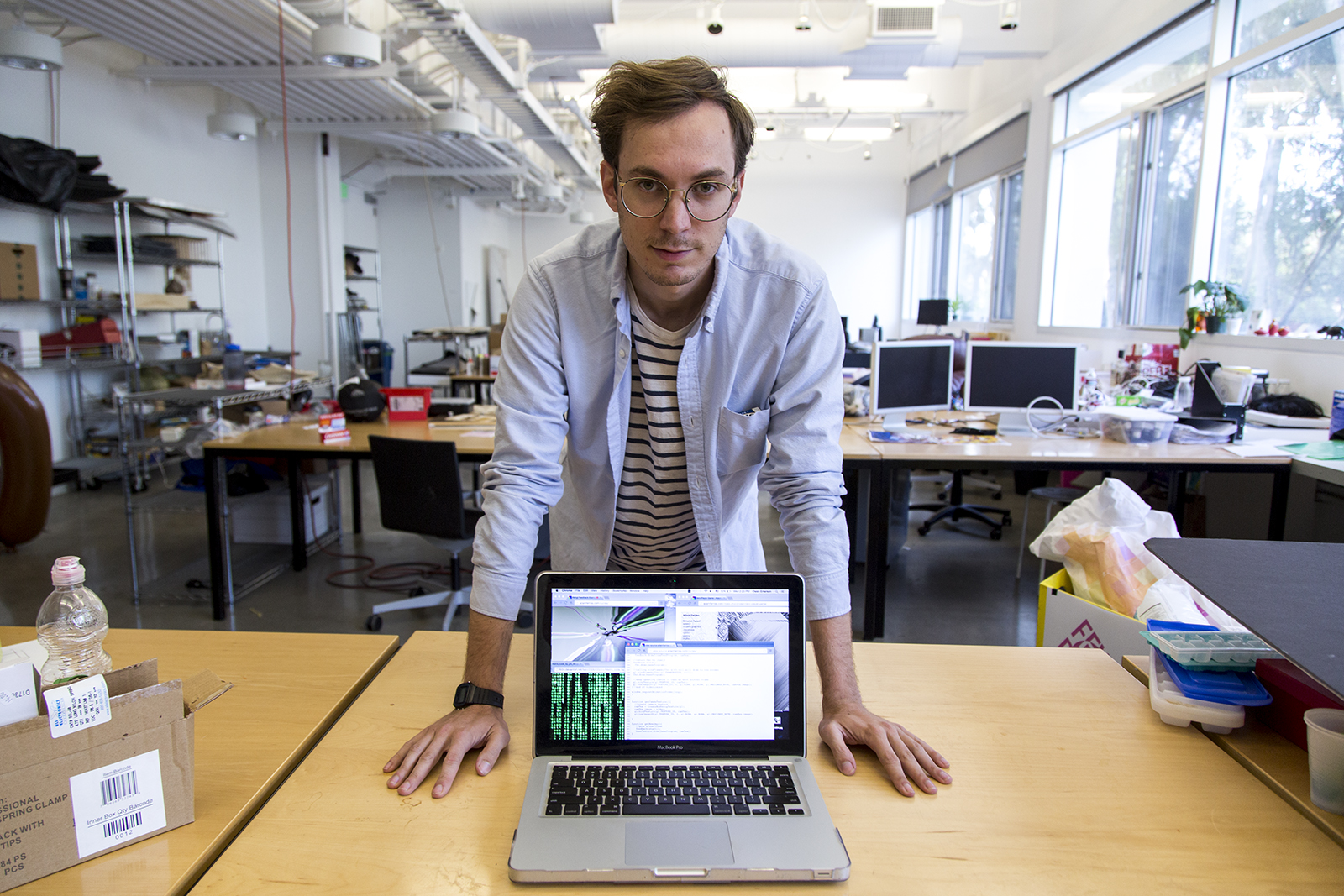Graduate student Adam Ferriss holds show featuring computer-coded art

Design | Media Arts graduate student Adam Ferriss will present his solo exhibition, “a wall with several poster painted on it.” at the Broad Art Center on Tuesday and Wednesday. Ferriss, a self-proclaimed software artist, designed his feedback loop after coding for at least two hours a day for more than a month.
(Owen Emerson/Daily Bruin)
By Daily Bruin Staff
Feb. 24, 2015 12:32 a.m.
A banana peel, a space shuttle at liftoff and a Hawaiian beach. Over and over, the projected images change, seeming to have no relation to one another. Yet they are all linked together by one thing – a feedback loop created by Design | Media Arts graduate student Adam Ferriss.
For the next several weeks, the Broad Art Center will have exhibits highlighting the Design | Media Arts program. Ferriss’ solo show “a wall with several poster painted on it.” will be on display Feb. 24 and 25 in the EDA room. The show features solely his feedback loop, which works with images, text and speech.
Ferriss said he is relatively new to the Design | Media Arts field. As an undergraduate at the Maryland Institute College of Art, he majored in photography. In his final semester, he took an interactive media course, which introduced him to website building and the basics of processing.
After that course, Ferriss said he became captivated by the technological side of art. He has since abandoned photography, focusing all of his attention on digital art practices.
“This felt very new to me since there’s a lot of unexplored possibilities in terms of breaking down images and reading out their data,” Ferriss said. “It’s like a brain puzzle where you progress a little bit and then there’s an even greater challenge.”
Over the last few years, Ferriss taught himself how to code. He said he also created individual projects in his own time to gain experience. One such project is a website he designed that grows patterns in accordance with a crystal growth rule.
“Ferriss is coming at the program with discipline and strong practice,” said Mat Dryhurst, a Design | Media Arts graduate student. “Browser-based art is a newer turn in this field, and Ferriss does a good job of it.”
Design | Media Arts graduate student Hsin-Yu Lu said Ferriss assigns himself a daily practice, inspiring other students by constantly creating new work.
Ferriss said his artistic interests vary, ranging from GIFs to self-growing images to website design.
When deciding which medium to feature in his solo show, Ferriss said he modeled the exhibit after a previous project he had done, which featured the computer’s ability to speak.
In preparation for the exhibit, Ferriss said he coded at least two hours a day for a month and a half.
The final result is a giant feedback loop which focuses on the capability of computers to speak, interpret data and transcribe words. Often, Ferriss said mistranslation and miscommunication occurs, which he views as an artistic opportunity.
“It’s about these insanely complex processes that are being developed. I am interested in the language that comes up around those processes and also how much nonsense it can become. It’s these two polarities of maximum complexity and complete nonsense,” Ferriss said.
Ferriss said the feedback loop consists of multiple steps.
First, a camera takes a shot of a projected image. This shot is sent into a deep-learning algorithm, which interprets the image and translates it into a sentence.
Next, the sentence is sent to a program which formulates a different sentence that is similar in meaning to the first.
The newly generated sentence is then spoken out loud by the computer. The computer writes down what it hears itself speak. Ferriss said this text-to-speech, speech-to-text feedback loop is similar to what Siri does on iPhones. And like Siri, what the computer hears and transcribes is not always accurate, creating another new sentence.
This last sentence is sent into a Google Image search, and the resulting new image is sent back to the beginning of the loop. Using this new image, the process begins again.
Ferriss said the name of the show, “a wall with several poster painted on it.,” was generated when the computer interpreted a photo of an art gallery show.
The loop is displayed on computer screen projections since, like Ferriss’ other works, the project is browser-based.
“As a graduate student, we kind of can do whatever we want in terms of our art-making,” Ferriss said. “It’s more about building a practice and learning how to keep yourself motivated, learning about theory and developing a network of peers.”
Although this project heavily relies on the use of text, browsers and code, Ferriss said he categorizes his work as art, not computer science.
“If you are a painter, your medium is paint,” Ferriss said. “If you are a photographer, your medium is a camera. I’m a software artist, so my medium is code and the digital screen.”


